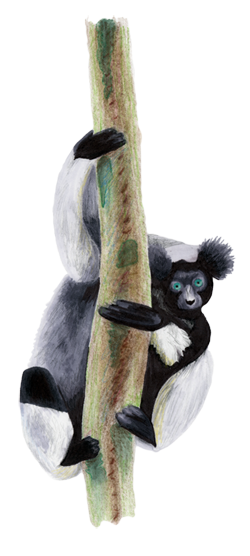A Unique Kind of Lemur
Most lemur species are arboreal. But the Ring-tailed is different in that it frequently uses the ground for travel, more than any of the other lemurs.
The Ring-Tailed Lemur certainly isn't the biggest, but it definitely isn't the smallest. In the list below you can see how it stacks up against other species.
- Indri - 21lbs
- Diademed Sifaka - 19lbs
- Milne-Edwards' - Sifaka 14lbs
- Black & White Ruffed Lemur - 7.9lbs
- Red Ruffed Lemur - 7.9lbs
- Ring-tailed Lemur - 7.7lbs
- Aye-Aye - 5.5lbs
- Sahamalaza Sportive Lemur - 1.97lb
- Coquerel's Giant Mouse Lemur - 11oz
- Madame Berthe's Mouse Lemur - 1.1oz
Social Groups
Ring-tailed lemurs are found in social groups ranging in size from three to 25 individuals. The groups are composed of both males and females. Females remain in their birth group throughout their lives. Generally males change groups when they reach sexual maturity, at age three. Ring-tail groups range over a considerable area each day in search of food, up to 3.5 miles. All group members use this common home range. Groups are often aggressive towards other groups at the border of these areas.
Females are dominant in the group, which means they have preferential access to food and choice of whom to mate with. This, like the gibbons, is unusual in the primate world. Males do have a dominance hierarchy, but this does not seem important during mating season because even low-ranking males are able to copulate.
These social bonds are established and reinforced by grooming. Prosimians groom in a rather unique way, all prosimians have six lower teeth, incisors and canines, that stick straight out from their jaw, forming a toothcomb. This comb is used to groom their fur and the fur of the other members of their social group.
Behavior
One of the most unusual lemur activities that ring-tailed lemurs participate in is sunbathing. The ring-tailed mob will gather in open areas of the forest and sit in what some call a yoga position facing the sun. They sit with their bellies toward the sun and their arms and legs stretched out to the sides. This position maximizes the exposure of the less densely covered underside to the sun. The temperature in the forest can be cold at night and this is a way to warm up before they forage.
Facial Expressions
Ring-tailed lemurs communicate visually in a number of ways. When ring-tail troops travel throughout their home range, they keep their tails raised in the air, like flags, to keep group members together. They also communicate using facial expressions. The list below explains what some of them mean among the lemur community.
- Staring open-mouth face: The eyes are opened wide, the mouth is open with the teeth covered by the lips. This occurs when mobbing a predator or serves to communicate an inhibited threat.
- Staring bared-teeth scream face: The eyes are opened wide, the mouth is open with the corners drawn back so that the teeth and gums are revealed. This display occurs with terror flight.
- Silent bared-teeth face: The eyes are staring at the stimulus, the eye brows are either relaxed or up, and the corners of the mouth are drawn back allowing the teeth to show. This is used to communicate submission or a friendly approach.
- Bared-teeth gecker face: Similar to silent bared-teeth face only with a rapid noise attached to it. This display occurs during subordinate flee-approach conflicts and also when an infant is bothered.
- Pout face: The eyes are opened wide and the lips are pushed forward such that the mouth resembles an “O” shape. This occurs with contact calls and also occurs with begging.
- Hoot face: The lips are pushed forward to resemble something called a “trumpet-mouth.” This display occurs with long-distance calls (e.g. territorial calls).
Diet
Lemurs are generally herbivorous, although when times get tough they become extremely opportunistic. Their diet consists of as many as three dozen different plant species, flowers, herbs, bark and sap. It has been observed eating decayed wood, earth, spider webs, insect cocoons, arthropods (spiders, caterpillars, cicadas and grasshoppers) and small vertebrates (birds and chameleons).
Reproduction
Females usually produce their first offspring at age three, and annually thereafter. This can happen as early as 18 months in captivity.
In the wild, mating is extremely seasonal beginning in mid-April with infants being born in August and September. Gestation lasts four and a half months. Generally ring-tailed lemurs give birth to one offspring, but twins can be a frequent sight if food is plentiful.
Initially, infants cling to their mother's belly, but after about two weeks, they can be seen riding jockey style, on their mother's back. Infants begin sampling solid food after about a week and will become increasingly independent after about a month. They return to mom to nurse or sleep until they are weaned at about five or six months of age. All adult females participate in raising the offspring of the group.



